Header logo
header top contact widget
Sore or swollen gums
Laser Dentistry, Cone Beam Imaging Among Our Advanced Features!
Posted on Nov 15, 2023 by William J. Claiborne, DDS MS
Like your “adult” teeth, your gum tissues are irreplaceable. Without question, they deserve the care and attention that come with keeping them healthy and doing their job.
Gum tissues are designed to protect the structures underneath. These include bones, tooth roots, tendons, and muscles to prevent entry of harmful bacteria. Gums are designed to snugly wrap the base of each tooth to keep bacteria from penetrating sensitive root segments of teeth.
Without this protective seal around teeth, the potential for periodontal (gum) disease greatly increases. And gum disease is at concerningly high levels in the U.S. with an estimated 47% of adults having some level of gum disease.
I believe that this high level of gum disease is largely in part due to Americans not being fully familiar with the symptoms. Some are easily ignored or “brushed off” as normal. This is why it is important to be familiar with the signs and symptoms, which include:
• Red, swollen or tender gums or other pain in your mouth
• Bleeding while brushing, flossing, or when eating certain foods
• Gums that pulling away from the base of teeth, making them appear teeth longer
• Loose or separating teeth
• Pus between your gums and teeth
• Sores in your mouth
• Persistent bad breath
• A change in the way your teeth fit together when biting
• A change in the fit of partial dentures
If you are experiencing any of these symptoms, you are urged to seek care with a periodontal specialist as soon as possible. This disease will only worsen without treatment.
Why should you be concerned about periodontal disease?
Gum disease is the nation’s leading cause of adult tooth loss. Additionally, research has linked the bacteria of periodontitis with serious health problems. These include heart disease, stroke, arthritis, diabetes, some cancers, preterm babies, erectile dysfunction (ED) and high blood pressure. Studies on links to Alzheimer’s disease are showing concerning correlations.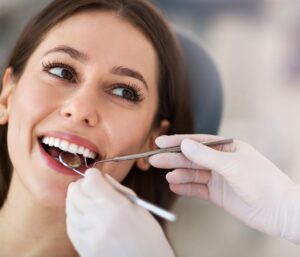
A periodontist is an expert in the treatment of all stages of gum disease, including gingivitis, periodontal disease, and the advanced form of periodontitis.
In addition to having these specific skills, I’d like to share the benefits of some of our amazing technology we make available to our Western NC patients. One with a wide range of benefits to patient care is our Dental Laser.
Nd: YAG Dental Laser: This is a small, hand-held device that eliminates or greatly minimizes bleeding during procedures. It also reduces numbing requirements, removes bacteria and easily uncovers gum tissue where dental implants have been placed.
Additionally, laser dentistry can quickly repair oral ulcers and beautifully re-contours or repairs gum tissue with a precision line. Some specific treatments that are ideal for a dental laser include:
Canker & Cold Sores: The laser is also ideal for rapid healing of canker and cold sores. Laser therapy can halt the progression of canker sores, reducing the pain in a day or so. Otherwise, they can last up to 2 weeks. When it comes to cold sores, they are best treated with our laser when the very first symptom arises. Tingling or burning sensation is the first sign that a cold sore is about to erupt. Although lasers can still treat these lesions in later stages, the treatment is most effective in initial stages. Most patients notice significant improvement in comfort after laser treatment with a much shorter duration.
Gum Disease Treatment: In our office, we also use a dental laser to destroy the bacteria of gum disease. This technology also speeds the process and heightens your comfort, saving you treatment time with faster healing.
Correcting a “Gummy Smile”: This is when a smile shows too much gum tissue above upper teeth when smiling fully. We correct this in a procedure known as crown lengthening. In this, a gingivectomy adjusts the height of gum tissues so the smile has a more even smile line. This may involve the use of a dental laser, which provides a precision line and speeds healing.
Balancing a smile line: A gingivectomy is also advised to rebalance the frame of gum tissues that arch the teeth visible in a smile. When one or two teeth have different heights of gum tissue, the smile has a jumbled look. A dental laser can even out the smile line and enhance the beauty of a smile.
Saving a tooth broken near the gum line: When a tooth breaks at or near the gum line, it often requires removal. In some cases, however, we can save the tooth by exposing enough of the structure to receive a crown. This helps the patient to avoid removal and thereby preserves the supporting jaw bone.
In our Asheville NC periodontal dental office, we feature additional technologies, some of the most advanced in the industry. These include:
LANAP Protocol Using PerioLase MVP-7: This process is designed to efficiently and effectively treat periodontitis (advanced gum disease) through laser technology. Treatment is administered with minimal (or no) discomfort and recovery time is minimal. Amazingly, this technology has also been able to stimulate bone regrowth in damaged areas.
Cone Beam 3D Imaging: These views allow us to see your jaw in 3D dimensions and to be able to view it at varying angles. This enables us to see what used to be hidden from view.
Cone Beam images are often used to assess:
• Dental Implant Positions
• Temporomandibular Joints (TMJ)
• Airway Passages
• Bone Structure Damage or Bone Loss
• Teeth, Tooth Roots and Facial Structures
• Signs Of Infections, Cysts, Or Tumors
CS 3600 Intraoral Scanner: Through this process, our patient no longer have impressions made with bulky, goopy trays held in their mouths. This technology quickly and comfortably scans the mouth’s interior for digital impressions using a small, handheld scanner. It can also reach difficult–to–access areas in the patient’s mouth with improved patient comfort.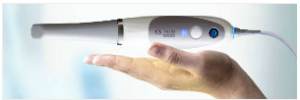
Simplant Dental Software for Computerized Dental Implant Placement: This system helps in pre-surgical positioning of dental implants on the computer, using a 3D model of the patient’s jaw. This aids in the selection of the implant type to ensure a precision fit.
Intraoral Camera Technology: This provides outstanding quality of images within the mouth. These images are sent to screen for a clear, crisp view so we can confer with patients on specific treatment needs.
Computer Imaging In Treatment Suites: Treatment suites are equipped with computers for convenient image sharing with patients.
Oral & IV Sedation: We take patient comfort very seriously in our Asheville periodontal dental office. That’s a commitment we make to every patient at every appointment. Here, patient comfort is supported by our sedation options. These include oral and I.V. sedation. Also referred to as “twilight sleep” or “sleep dentistry,” these sedatives are administered by a highly-skilled anesthesiologist who uses advanced safety monitoring equipment throughout the patient’s procedure.
My staff and I also take great pride in providing patients with an environment of respect. Some adults come to us embarrassed by the condition of their oral health or missing teeth. Here, we strive to make patients feel they are in the right hands in the right place.
If tooth loss has occurred, a periodontist also specializes in the selection and placement of all types of dental implants. Dental implants, for many reasons, are the preferred option for tooth replacement.
Call 828-274-9440 to schedule a consultation in our state-of-the-art Asheville periodontal dental office. New patients are always welcome and a referral is not always necessary.
Know How Oral Bacteria Form & Cause Damage
Posted on Nov 07, 2023 by William J. Claiborne, DDS MS
Often, once people understand how something breaks down, they are able to watch for telltale signs or take preventive measures. For example, when the grooves in a vehicle’s tires become more shallow, it’s obvious they need to make arrangements for new tires.
This is true, also, for your oral health. Knowing concerning oral signs and symptoms can help you prevent cavities, periodontal (gum) disease and tooth loss.
Oral bacteria exists in every mouth; some of it is “good” bacteria. The good bacteria are even helpful to the digestive system. However, harmful bacteria can run rampant if not kept under control.
The average mouth houses around 20 billion (that’s billion with a “b”), consisting of about 700 different types. Bacteria breed very quickly. The numbers can grow amazingly fast and their buildup produces a bacterial film that coats the teeth and gums. This is known as plaque.
Plaque is the sticky coating in your mouth, most obvious when you first wake up. When plaque is not removed regularly (through thorough brushing), the bacteria attack tooth enamel. Results include bad breath, yellowed teeth, cavities and tender gums.
Plaque formation actually begins as you chew carbohydrates, which seems to be prevalent in most of the foods we eat in today’s diet. As carbohydrates blend with saliva and existing bacteria in the mouth, an acid is created.
Plaque that is allowed to remain on teeth for about 48 hours hardens. This is known as tartar, which is a mass of bacteria that forms between and at the base of teeth.
Once in this hardened form, removal can only occur with special tools used by your dentist or dental hygienist. This is what your hygienist is scraping off during cleanings. Without tartar being removed, it causes the gums to swell, feel tender and may bleed when brushing. This is typically the initial stage of gum disease, known as gingivitis.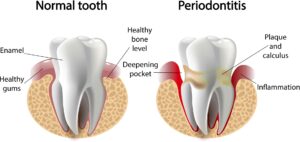
However, for people who brush twice a day and still have tartar formation between dental hygiene appointments, there are factors that may be contributing. Some of these are not common knowledge, which is important to know in your prevention goals. These include:
Having “dry mouth”: There are a number of reasons that some people suffer with a drier mouth than others. Unfortunately, those who have insufficient saliva flow (which continually helps to cleanse the mouth) are more susceptible to tooth decay from plaque and tartar.
Saliva protects teeth and gums by helping to manage the growth of harmful bacteria while maintaining a neutral pH in the mouth. This slows microbial growth and keeps bacteria from sticking to teeth.
Other contributors to dry mouth include aging, caffeine (including coffee, tea, sodas, and chocolate), smoking, and a wide range of medications (such as antidepressants, decongestants and diuretics).
Poor oral hygiene: Since the pandemic, normal routines have been uprooted for many people as they have adjusted their “ready for the day” tasks to more casual timetables. Unfortunately, this seems to have left the habitual brushing and flossing times to days where oral hygiene has dropped out of the twice-a-day routine.
A March 2023 poll (conducted on behalf of CeraVe) included 2,000 men between the ages of 18 – 42. They found that only 54% brush their teeth daily (with one-third admitting to only once a day when they do brush). To no surprise, a recent report by the Centers for Disease Control & Prevention reveals that nearly 26% of ages 20 – 44 have untreated dental caries.
Frequent snacking: Every time you eat or drink, an acid attack begins in the mouth. This acid flows in with saliva to begin the initial stage of digestion. However, this acid is very potent, enough to even soften tooth enamel. So, every time you take a bite of a cookie, acid flows into the mouth and remains there for about 20-30 minutes. When the mouth endures frequent acid attacks from snacking between meals, the damage to precious tooth enamel will catch up to you in the form of cavities.
In addition to the harm that oral bacteria can cause teeth, the gum tissues – essentially the protective coating to the vital structures that support teeth – endure the rigors of bacterial overload. Eventually, this catches up to most people in the form of:
• Gingivitis – As the initial stage of gum disease, inflammation is triggered by plaque buildup at the gum line. When daily brushing and flossing fail to thoroughly remove plaque, toxins form that cause irritation to the gum tissues. Once symptoms emerge, they may include seeing blood in the sink when brushing or having sore, swollen gums.
• Periodontitis – As the disease advances, the bone structures and fibers that support teeth are damaged by the destruction of infectious oral bacteria. At this stage, pockets form below the gum line, filling with bacteria-laden plaque.
• Advanced Periodontitis – In the advanced stage of gum disease, fibers and bone supporting natural teeth are destroyed. This can cause teeth to shift or loosen, requiring aggressive treatment to prevent tooth loss. Eventually, some teeth may require removal.
Proactive measures NOW can help you avoid costly repairs to teeth, tooth replacement or the treatment process to rid periodontal disease. Start now with:
– Brush twice daily, floss every day and maintain regular dental check-ups. Thorough at-home oral care and regular dental check-ups can help you avoid problems from occurring in the first place.
– Delay brushing after eating or drinking. Wait 20-30 minutes to allow the acid attack in your mouth to subside. Remember, this acid can soften tooth enamel. The abrasiveness of a tooth brush or tooth paste can wear away precious tooth enamel.
– Swish with water. Enjoy a cup of coffee or glass of wine but try to alter these with a glass of water, allowing it to wash over teeth before swallowing. Or, swish with water.
– Eat sweets only with meals. Rather than forgo a sweet indulgence as a snack, enjoy your favorites as dessert following your meal since your mouth is already enduring an acid attack. This merely prolongs an acid attack rather than trigger a new one.
A healthy mouth is important for your overall health, as research has shown. We now know that the inflammatory bacteria of periodontal (gum) disease are able to enter the bloodstream through tears in weakened gum tissues. Numerous studies have found this bacteria can trigger harmful reactions.
For example, the bacteria can cause inflammation that sets into motion risks factors connected to arthritis and diabetes. Some cancers have also been correlated to this bacteria. Heart disease, stroke and high blood pressure have been as well. Alzheimer’s is also being studied along these lines.
While there is no clear pathway to verify gum disease bacteria are the “cause” of these serious conditions, research has continually shown they are linked, which can greatly increase one’s potential for having these problems develop (or worsen).
If you haven’t been fully committed to your oral health, there is no better time to begin than the present. Start with a thorough periodontal examination by calling 828-274-9440.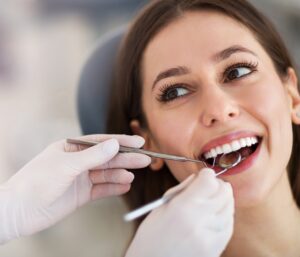
If dental fears have caused you to delay or avoid regular dental care, consider beginning with a consultation. This occurs in a comfortable, private room that is removed from the clinical side of the office. Too, many treatments can include oral or IV sedation (sleep dentistry, or “twilight sleep”).
And, if budget constraints are an obstacle, we offer several payment plans. Most are interest-free with no down payment required (for qualified individuals). Feel free to ask about these during your consultation.
Sources:
www.todaysrdh.com/
perio.org
It’s Flu Season – Why You Should Keep Your Oral Health In Tip-Top Shape.
Posted on Oct 16, 2023 by William J. Claiborne, DDS MS
It’s cold and flu season. Now having weathered the worst pandemic Americans have ever experienced, a new emphasis has taken hold for the need to have flu vaccines and the latest Covid booster.
Vaccines, of course, do not fully eliminate the potential to acquire these health conditions. While they lower the chances of their development, the immune system still relies on our own actions. This includes taking measures to avoid their development in the first place, such as frequent handwashing, eating a healthy diet, mask-wearing in crowds for vulnerable populations, etc.
We learned much about the immune system during the Covid pandemic. And, the need for keeping oral health in good condition became more clear than ever.
During the worst of the outbreak, a 2020 study found that individuals with gum disease who contracted COVID-19 were 9 times more likely to die. And, the study showed that COVID patients who already had periodontitis (the advanced form of gum disease) were 3 times more likely to end up in intensive care or on a ventilator.
Evidence shows, too, that avoiding dental care may actually increase the potential to contract the virus. And, poor oral health can increase its severity, and even fatality rates.
https://onlinelibrary.wiley.com/doi/10.1111/jcpe.13435
This is not only a concern for U.S. citizens, it’s a worldwide wake-up call. About 50% of the world’s population over the age of 30 suffer from periodontitis. Americans aren’t in much better shape – with over 47% having some form of gum disease.
Because gum disease can begin without obvious symptoms, or be present without having pain, it can be easily ignored. This allows the disease to progress further.
This is why dental care is deemed by Congress as “essential healthcare,” as it supports the need for preventive measures for gum disease and tooth loss. As a periodontist, I believe it is also important that Americans understand the signs and symptoms of gum disease as well as the overall health risks it brings.
Although gum disease can exist without obvious indication (typically in the early stage known as gingivitis), warning signs of gum disease usually begin with swollen and tender gums that bleed easily when brushing teeth.
As it worsens, the healthy pink hue of gums darkens to more of a red or purple color and breath odor is persistently bad. The gums begin to loosen their strong grip around the base of teeth, allowing infectious bacteria to reach bone structures that support tooth roots. In advanced stages, pus pockets form near the base of some teeth and gum tissues become spongy in texture.
The bacteria of periodontal disease don’t just damage oral health. This is where there is so much concern throughout the healthcare fields.
Through weakened oral tissues, the bacteria can enter the bloodstream and trigger inflammatory reactions. These reactions can worsen some serious health conditions and even activate others. Research has found correlations between these bacteria and heart disease, stroke, diabetes, arthritis, some cancers (including pancreatic), preterm babies, erectile dysfunction, and Alzheimer’s disease.
With such serious correlations, it should be common knowledge that oral wellness is a necessary part of maintaining good overall health. However, this isn’t necessarily the case. A report commissioned by Delta Dental Plans Association recently revealed concerning information regarding age groups and perceptions of oral health.
With over 1,000 online participants, 87% listed their priority for maintaining proper oral care was to save money or avoid unexpected expenses. Two-thirds of the group listed their commitment to at-home dental hygiene being to avoid tooth decay and gum disease. Yet, only 79% of adults stated they brushed their teeth twice a day with only 33% claiming to floss daily.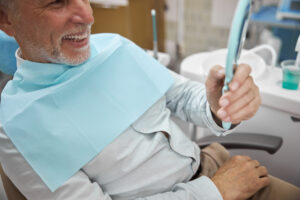
In reviewing age groups, the report found that baby boomers (those born between 1946 – 1964) understand there is a strong link between their oral and overall health but are less aware than other generations about the connection between poor dental health and chronic diseases (such as arthritis and diabetes).
Those listed in the Generation Z group (born between 1997 – 2012) showed less commitment to their oral health as the “boomers,” but were more focused on eco-friendly and nontraditional oral care products. Only 76% of Generation Z agreed that oral health is closely connected to overall health.
If you wear dentures or partials, keeping them clean is an important measure to take to avoid getting sick. Why?
One study (published in the Journal of The American Dental Association) assessed bacteria levels of the porous material that make up the gum base of dentures and partials. In the mouth, it becomes coated with a sticky bacteria known as biofilm.
One study found that wearing dentures while sleeping doubles the risk of pneumonia in elderly adults. (https://www.ncbi.nlm.nih.gov/pmc/articles/PMC4541085/)
It has also been found that this biofilm can harbor MRSA or bacteria that is resistant to antibiotics. It was also found that the bacteria in the biofilm doesn’t just stay in the mouth. It can be inhaled into the lungs where infections become much more difficult to treat. (https://www.nbcnews.com/healthmain/dirty-dentures-dangerous-mrsa-may-be-lurking-dentists-say-662637)
Regardless of age, Americans must maintain a healthy smile in order to support their immune systems. Research shows that oral bacteria are also connected to gut health, so keeping bacteria levels in the mouth in check can go a long way in healthy benefits far beyond the mouth.
For those who have avoided regular dental care due to dental fear or anxiety, we offer several comfort options, including oral and IV sedation.
Oral sedation is a pill that helps patients relax. I.V. sedation (also known as ‘twilight sleep’) places the patient in a deeper sleep state and erases memory of the procedure. It is administered by a doctor of anesthesiology for optimal comfort and safety with patients closely monitored with advanced safety equipment throughout treatment.
Call 828-274-9440 to arrange an examination appointment or to learn more about our Asheville periodontal dental office.
A “Lecture-Free” Look At Cigarettes & Your Smile
Posted on Oct 11, 2023 by William J. Claiborne, DDS MS
In this article, I’m going to address cigarette smoking as it affects oral health. This is not intended to lecture or chastise an adult for making a choice to smoke or those caught up in the addictive grip of nicotine. My goal is to relay factual information regarding oral health for smokers so they can better protect their smiles.
Because I’m a native North Carolinian, I’ll begin by sharing some information on our State, as provided by 2018 stats from the CDC (Centers for Disease Control & Prevention).
In 2018, the percentage of adults in North Carolina who smoked was reported as 17.4% (of every 100 adults). The CDC shared findings of all states, with smoking ranged from nearly 9 of every 100 adults in Utah (9.0%) to 25 of every 100 adults in West Virginia (25.2%).
They also shared that cigarette smoking was lowest among those with a graduate degree (3.2%) and highest for those who had only achieved a GED certificate (30.7%). Those with a high school diploma showed a lower percentage of nearly half of the GED level adults at 17.1%.
As an Asheville periodontal dental specialist, smoking is a particular concern since many people are unaware of the oral health risks. While many smokers are familiar with the risks smoking poses related to cancer and other diseases, smoking is also terribly harmful to your smile.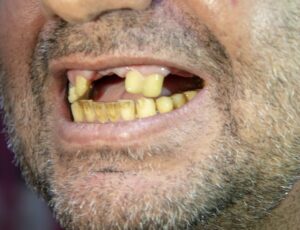
For instance, smokers have a greater risk of periodontal (gum) disease. The drying effect that smoking has on the soft tissues in the mouth offers an ideal breeding ground for oral bacteria. This enables easier entry of oral bacteria into the structures that support tooth roots.
According to the Centers for Disease Control & Prevention (CDC), a smoker has twice the risk for gum disease compared to that of a nonsmoker.
As oral bacteria thrive and reproduce in the mouth, gum tissues become tender and inflamed. These are signs of gingivitis, the beginning stage of gum disease.
Gum disease at this stage can cause persistent bad breath, swollen gums and gums that bleed easily when brushing. As it progresses, gum tissues turn red or purple from inflammation. Pus pockets may form at the base of some teeth. This advanced stage is known as periodontitis.
Eventually, the infectious bacteria penetrate below the gum line and attack supporting bone and the tissues surrounding tooth roots. This can cause teeth to loosen and eventually require removal. Gum disease is the nation’s leading cause of adult tooth loss.
Losing teeth is detrimental to your overall health and not a normal part of the aging process. Studies have shown that people who wear dentures die an average of ten years earlier than those who keep their natural teeth.
Denture wearers also have higher incidences of pneumonia, and worse. A 2015 report by NBC News shared findings surrounding dentures and MRSA biofilm. The report included a dental specialist’s warning that, “Concern about biofilms on dentures is growing as researchers continue to identify links between oral bacteria and heart disease, chronic obstructive pulmonary disease or COPD, and respiratory diseases, including aspiration pneumonia.”
Many smokers are aware that they have stained teeth and more-frequent bad breath than non-smokers. They also have slower healing periods after procedures such as extractions, gum treatment and oral surgery.
Although a hygienist may go slowly and gently, dental cleanings are typically less comfortable for smokers. This is because smoking causes a greater buildup of plaque. With gum tissues already tender from the bacterial irritation of plaque, removing buildup from between and around the base of teeth adds to the discomfort of inflamed tissues.
According to the American Dental Association (ADA), smoking increases the risks of oral cancer, lesions inside the mouth, enamel erosion and tooth loss in addition to periodontal (gum) disease.
If you vape, remember that nicotine in any form is a hazardous force in the mouth. And the vapor itself is not safe for oral health.
Vaping (using e-cigarettes) delivers nicotine through an inhaled mist. Although the vapor is generally not labeled as “dangerous,” one study of some e-cigarette products found the vapor contains known carcinogens and toxic chemicals, including, propylene or polyethylene glycol, glycerin, and additives. And, its nicotine is no less harmful to the user as that delivered via cigarette smoke.
Unfortunately, many cigarette users switch to vaping based on the perception that “e-cigs” are a safer alternative. For those hoping to wean themselves off cigarettes through this switch, very few achieve that goal as a result.
A 2018 report by the National Academy of Sciences, Engineering, and Medicine concluded there was “evidence that e-cigarette use increases the frequency and intensity of cigarette smoking in the future.”
Although the focus in this article is meant to be on oral health, allow me to reiterate some of the benefits of “kicking the habit” …
• Smokers have a decreased life expectancy of an average of 10–15 years compared to non-smokers.
• Smoking is linked to nearly a third of all cancer diseases and deaths.
• Pregnant women who smoke have a higher risk for first-trimester spontaneous abortion, preterm births, low birth weight babies and sudden infant death syndrome (SIDS).
• Women who smoke are at risk for early menopause while men who smoke are more at risk for impotency.
• People who breathe in your “second hand” smoke (what you exhale) are subjected to over 50 known carcinogens and other harmful chemicals.
For those who are able to give up smoking, the effort is well worth it. The positive effects can be felt almost immediately. In about 48 hours, damaged nerve endings begin to restore. The sense of smell and taste begin to return to normal.
“Quitters” also notice their breathing is easier in about 3 days and they have fuller air intake. Oral health improves within 2 weeks as blood circulation in the gums and teeth returns to nearly that of non-smokers. Heart attack risk also declines with blood flow greatly improving. Activities are easier and the constant smokers cough is gone.
 In our Asheville periodontal office, our goal – for every patient – is to help each achieve optimal oral health and a smile he or she is proud to share. For those who smoke, we make individualized recommendations so the potential for achieving this is favorable.
In our Asheville periodontal office, our goal – for every patient – is to help each achieve optimal oral health and a smile he or she is proud to share. For those who smoke, we make individualized recommendations so the potential for achieving this is favorable.
If tooth loss has already occurred, we are specialists in the treatment of all stages of gum disease and in the diagnosis and placement of dental implants. We will be happy to discuss the dental implant system that may be best for your needs.
Or, if dental fear or anxiety have kept you from receiving regular dental care, ask us about oral or IV sedation (“twilight sleep”). These sedatives are delivered by an MD of anesthesia for your optimal safety and comfort. And, in all procedures, we make patient comfort a high priority.
Call 828-274-9440 to schedule an examination.
Sources:
https://www.cdc.gov/tobacco/campaign/tips/diseases/periodontal-gum-disease.html
https://www.sciencedaily.com/releases/2016/11/161116101821.htm
https://www.nbcnews.com/healthmain/dirty-dentures-dangerous-mrsa-may-be-lurking-dentists-say-662637
https://www.cdc.gov/tobacco/basic_information/e-cigarettes/index.htm
Recent Posts
Categories
Archives
- September 2024
- August 2024
- July 2024
- June 2024
- May 2024
- April 2024
- March 2024
- February 2024
- January 2024
- December 2023
- November 2023
- October 2023
- September 2023
- August 2023
- July 2023
- June 2023
- May 2023
- April 2023
- March 2023
- February 2023
- January 2023
- December 2022
- November 2022
- October 2022
- September 2022
- August 2022
- July 2022
- June 2022
- May 2022
- April 2022
- March 2022
- February 2022
- January 2022
- December 2021
- November 2021
- October 2021
- September 2021
- August 2021
- July 2021
- June 2021
- May 2021
- April 2021
- March 2021
- February 2021
- January 2021
- December 2020
- November 2020
- October 2020
- September 2020
- August 2020
- July 2020
- June 2020
- May 2020
- April 2020
- March 2020
- February 2020
- January 2020
- December 2019
- November 2019
- October 2019
- September 2019
- August 2019
- July 2019
- June 2019
- May 2019
- April 2019
- March 2019
- February 2019
- January 2019
- December 2018
- November 2018
- October 2018
- September 2018
- August 2018
- July 2018
- June 2018
- May 2018
- April 2018
- March 2018
- February 2018
- January 2018
- December 2017
- November 2017
- October 2017
- September 2017
- August 2017
- July 2017
- June 2017
- May 2017
- April 2017
- March 2017
- February 2017
- January 2017
- December 2016
- November 2016
- October 2016
- September 2016
- August 2016
- July 2016
- June 2016
- May 2016
- April 2016
- March 2016
- February 2016
- January 2016
- December 2015
- November 2015
- October 2015
- September 2015
- August 2015
- July 2015
- June 2015
- May 2015
- April 2015
- March 2015
- February 2015
- January 2015
- December 2014
- November 2014
- October 2014
- September 2014
- August 2014
- July 2014
- June 2014
- May 2014
- April 2014
- March 2014
- February 2014
- January 2014
- December 2013
- November 2013
- October 2013
- September 2013
- August 2013
- July 2013
- June 2013
- May 2013
- April 2013
- March 2013
- February 2013
- January 2013
- December 2012
- November 2012
- October 2012
- September 2012
- August 2012
- July 2012
- June 2012


